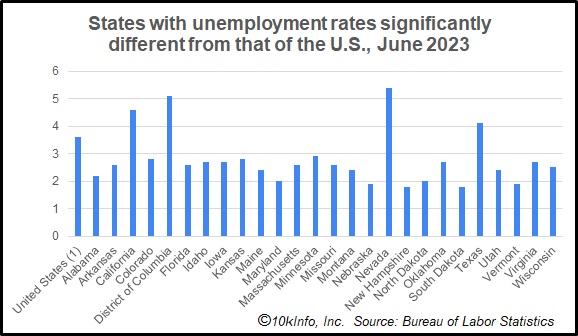Unemployment Rates Decline in 11 States, New Hampshire and South Dakota Record Lowest Jobless Rates
Economic Recovery Gathers Strength as Nonfarm Payroll Employment Shows Steady Growth
The U.S. Bureau of Labor Statistics has released the latest employment data, revealing a mixed picture of the nation's economic recovery in June 2023. Unemployment rates declined in 11 states, with New Hampshire and South Dakota boasting the lowest jobless rates. Meanwhile, nonfarm payroll employment showed steady growth, with Texas leading the way in job increases over the year.
Read more: US applications for jobless benefits fall again as labor market continues to defy the Fed actions
According to the U.S. Bureau of Labor Statistics, unemployment rates displayed a positive trend in June 2023, with 11 states witnessing a decline in joblessness. Both New Hampshire and South Dakota recorded the lowest jobless rates at an impressive 1.8 percent each. Following closely behind were Nebraska and Vermont, each reporting a 1.9 percent jobless rate.
Jobless rates hit new low in several states
Moreover, several states achieved significant milestones as their unemployment rates hit new series lows. Arkansas, Maryland, Massachusetts, Mississippi, New Hampshire, Ohio, Oklahoma, Pennsylvania, and South Dakota all saw their jobless rates reach record lows, providing a promising outlook for their economies. Conversely, Nevada faced challenges with the highest unemployment rate, reaching 5.4 percent.
Overall, 22 states reported unemployment rates lower than the national average of 3.6 percent, while three states and the District of Columbia experienced higher rates. The remaining 25 states had rates that remained relatively unchanged, showcasing stability in their employment landscapes.

When analyzing the data over the year, 22 states exhibited significant improvements in their unemployment rates. Maryland and Massachusetts led the way with the largest rate decreases of 1.2 and 1.1 percentage points, respectively. On the other hand, eight states and the District of Columbia saw an increase in their jobless rates from June 2022, with California and the District experiencing the most considerable rise at 0.7 percentage points each.
Nonfarm jobs mark steady growth
Shifting focus to nonfarm payroll employment, the statistics demonstrated steady growth. In June 2023, employment increased in five states, remained unchanged in 43 states and the District of Columbia, and decreased in only two states. New York saw the largest job gains with an impressive increase of 28,100 positions, followed by Alabama (+8,400) and New Mexico (+7,300). Alaska exhibited the highest percentage increase in employment at 0.9 percent, closely trailed by New Mexico and Wyoming, both at 0.8 percent. However, Indiana and Vermont experienced a decline in employment by 13,900 (-0.4 percent) and 4,300 (-1.4 percent) jobs, respectively.
Over the year, nonfarm payroll employment displayed resilience, with 41 states experiencing growth, while nine states and the District of Columbia remained relatively stable. Leading the nation in job gains were Texas, California, and Florida, recording increases of 542,500, 397,400, and 319,500 jobs, respectively. In terms of percentage increases, Nevada and Texas led the way, both at an impressive 4.0 percent, closely followed by New Mexico at 3.8 percent.
Labor statistics
The U.S. Bureau of Labor Statistics gathers this valuable employment data through two monthly programs, involving surveys of households and establishments. These statistics offer crucial insights into the state of the nation's job market and the health of regional economies.
For more information on the methodology and concepts underpinning these reports, refer to the Technical Note provided by the U.S. Bureau of Labor Statistics. As the nation continues its path toward economic recovery, policymakers and businesses alike will undoubtedly scrutinize these data to make informed decisions and support further growth.




